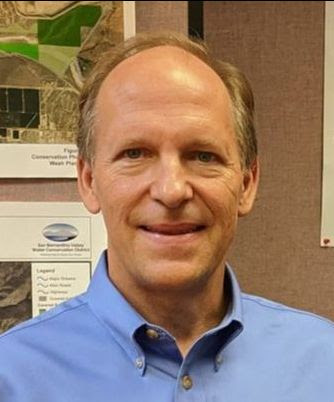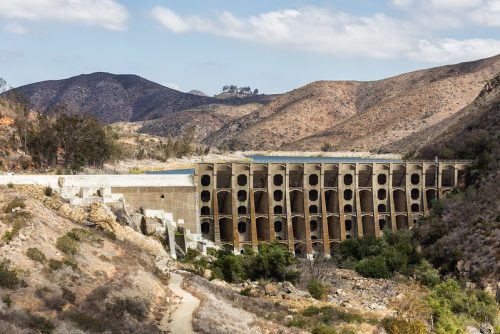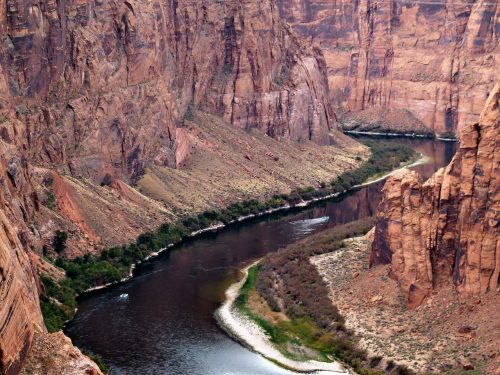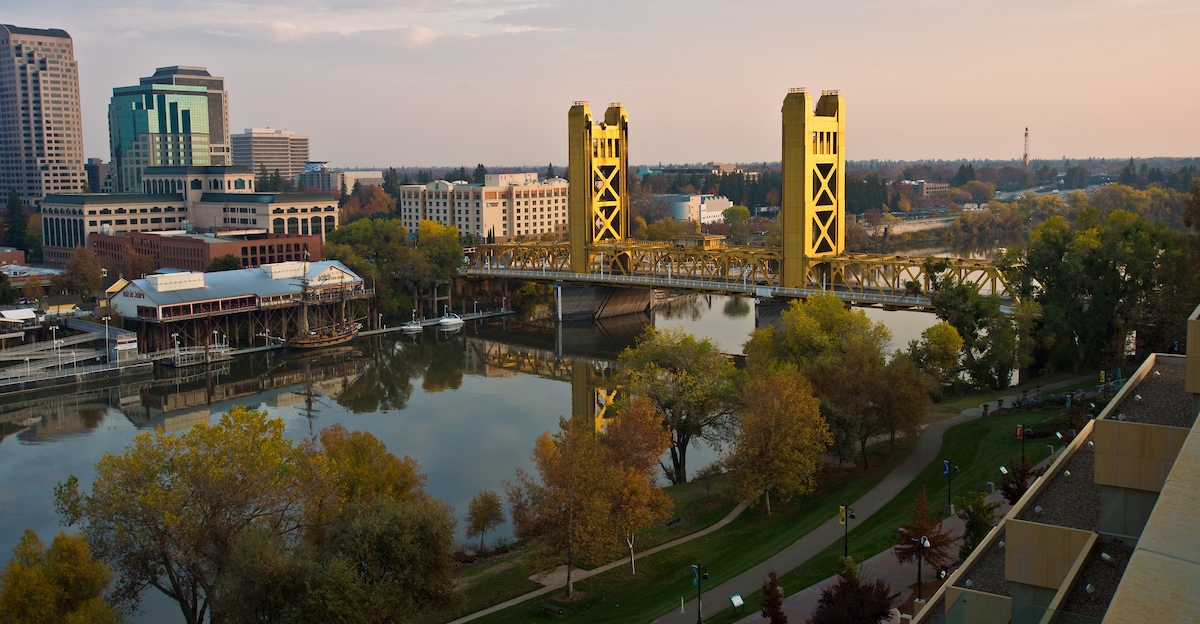In California water news this weekend …
The two largest reservoirs in California are already at ‘critically low levels’ and the dry season is just starting
“Against the backdrop of the water crisis in the Colorado River Basin, where the country’s largest reservoirs are plunging at an alarming rate, California’s two largest reservoirs — Shasta Lake and Lake Oroville — are facing a similar struggle. Years of low rainfall and snowpack and more intense heat waves have fed directly to the state’s multiyear, unrelenting drought conditions, rapidly draining statewide reservoirs. And according to this week’s report from the US Drought Monitor, the two major reservoirs are at “critically low levels” at the point of the year when they should be the highest. This week, Shasta Lake is only at 40% of its total capacity, the lowest it has ever been at the start of May since record-keeping began in 1977. Meanwhile, further south, Lake Oroville is at 55% of its capacity, which is 70% of where it should be around this time on average. ... ” Read more from CNN via KAKE here: The two largest reservoirs in California are already at ‘critically low levels’ and the dry season is just starting
Federal and state agencies submit the 2022 Sacramento River Temperature Management Plan
“After the driest January, February, and March ever recorded, state and federal agencies, water users, communities, and others are pulling together to make the most of extremely limited water supplies in one of the driest years on record in California. The Sacramento River Temperature Management Plan and efforts to manage water this year on the Sacramento River reflect unparalleled collaboration, sacrifice, and innovation to help fish, wildlife, and farms survive what may be the most difficult water year we have ever faced. Current drought conditions called for difficult decisions to be made this year with far reaching impacts. We are now joining together to implement innovative strategies for fish and wildlife to promote survival across different watersheds, as well as working together to address the unprecedented dry year impacts to farmers, water suppliers, and the communities in the Sacramento Valley dependent upon these water supplies.” The joint efforts include the Bureau of Reclamation, NOAA Fisheries, U.S. Fish and Wildlife Service, California Environmental Protection Agency, California Department of Water Resources, California Department of Fish and Wildlife, and Sacramento River Settlement Contractors.
In commentary this weekend …
Restore the Delta: The late invitation
“Dear Director Nemeth, Thank you for your email regarding the upcoming voluntary agreement governance meetings. At this time, Restore the Delta is respectfully declining your invitation. I would like to share a few reasons behind our decision to forego participation. First, we feel this invitation has come too late within the voluntary agreement process, unless the process started over with representatives from all the impacted parties at the table from the beginning — a redo so to speak. Restore the Delta has been asking for a seat at the table since 2019. We offered you and DWR staff tours. We wrote a report around our concerns regarding climate resiliency that we shared with DWR and the Resources Agency. We offered extensive comments around the Water Portfolio, HABs issues, DSC processes and planning, and comment letters to the State Water Resources Control Board regarding Delta management in relation to drought and the need for a Bay-Delta Plan, or at least an inclusive voluntary agreement process rooted in equity. We have been quite prolific in communicating our views, concerns, and recommendations. ... ” Read more from Restore the Delta here: Restore the Delta: The late invitation
Why the West is running out of water and can’t get more
The Las Vegas Review-Journal editorial board writes, “When beavers make a dam that redirects a river, they don’t wait for an environmental permit. When a volcano erupts, the Hawaiian goddess Pele doesn’t first fret over carbon emissions. A hungry cat doesn’t care if the bird it’s eating is endangered or not. At some point, the environmental movement needs to remember that humans are part of nature, too. … Increasingly, it seems that modern-day greens aren’t interested in more sustainable human progress but in blocking that progress regardless. It speaks volumes that Gov. Newsom now represents the voice of reason on his state’s water dilemma. Desalination plants hold tremendous potential for addressing water shortages. … ” Read the full editorial at the Las Vegas Review-Journal here: Why the West is running out of water and can’t get more
In people news this weekend …
A life written in water: Susan Tatayon reflects on her 40-year career
 “Susan Tatayon has spent four decades working in California’s water world, most recently as chair of the Delta Stewardship Council. (She was appointed by Governor Brown in 2014 and reappointed in 2018.) She retired from state service in 2022. We caught up with her to gather a few gems of wisdom, calling on her unparalleled understanding of water in a state that’s facing bigger water challenges than ever. Q: You have worked on California’s water issues from almost every conceivable angle—at organizations including Department of Water Resources (DWR), the Bureau of Reclamation, The Nature Conservancy, and more. What are your biggest takeaways from those decades? A: There have been so many lessons along the way. One big thing I learned is that you can get an awful lot done if you can get state and federal agencies moving in the same direction. … ” Read more from the PPIC here: A life written in water: Susan Tatayon reflects on her 40-year career
“Susan Tatayon has spent four decades working in California’s water world, most recently as chair of the Delta Stewardship Council. (She was appointed by Governor Brown in 2014 and reappointed in 2018.) She retired from state service in 2022. We caught up with her to gather a few gems of wisdom, calling on her unparalleled understanding of water in a state that’s facing bigger water challenges than ever. Q: You have worked on California’s water issues from almost every conceivable angle—at organizations including Department of Water Resources (DWR), the Bureau of Reclamation, The Nature Conservancy, and more. What are your biggest takeaways from those decades? A: There have been so many lessons along the way. One big thing I learned is that you can get an awful lot done if you can get state and federal agencies moving in the same direction. … ” Read more from the PPIC here: A life written in water: Susan Tatayon reflects on her 40-year career
Roger Cornwell joins Sutter Mutual and RD 1500 as new general manager
 “The Board of Trustees for the Basin Irrigation District and Drainage Authority are pleased to announce that Roger Cornwell has joined Sutter Mutual Water Company and Reclamation District 1500 as their General Manager. In this capacity, Roger will also serve as the General Manager for the Basin Irrigation and Drainage Authority—the Joint Powers Authority of Reclamation District 1500 and Sutter Mutual Water Company. Roger brings an amazing combination of leadership and technical experience and skills to the Sutter Basin for the benefit of its landowners, water users and community; our many partners throughout California; and for a functional ecosystem in the region. … ” Continue reading at the Northern California Water Association here: Roger Cornwell joins Sutter Mutual and RD 1500 as new general manager
“The Board of Trustees for the Basin Irrigation District and Drainage Authority are pleased to announce that Roger Cornwell has joined Sutter Mutual Water Company and Reclamation District 1500 as their General Manager. In this capacity, Roger will also serve as the General Manager for the Basin Irrigation and Drainage Authority—the Joint Powers Authority of Reclamation District 1500 and Sutter Mutual Water Company. Roger brings an amazing combination of leadership and technical experience and skills to the Sutter Basin for the benefit of its landowners, water users and community; our many partners throughout California; and for a functional ecosystem in the region. … ” Continue reading at the Northern California Water Association here: Roger Cornwell joins Sutter Mutual and RD 1500 as new general manager
Chuck Williams, longest-serving Kern River Watermaster, dies at 93
“Chuck Williams, the longest serving “interim, acting” Kern River Watermaster, died Friday. He was 93. Attorney Scott Kuney, who worked with Williams at North Kern Water Storage District, remembered Williams as a “man of great faith, integrity and a consensus maker. “And he was fun,” Kuney said Friday. “He had a thousand stories.” Kuney recalled driving up the Kern River Canyon for a meeting and Williams, at the wheel and speaking with his hands, got too close to the canyon wall, ripping open a tire. “So, there we were changing the tire at the side of the canyon and he still finished the story. He didn’t miss a beat.” … ” Read more from SJV Water here: Chuck Williams, longest-serving Kern River Watermaster, dies at 93
SBVWCD General Manager Daniel Cozad receives statewide honor
 “California’s leading voice on water issues this week honored San Bernardino Valley Water Conservation District General Manager Daniel Cozad with its 2022 Excellence in Water Leadership Award. Praising him for his leadership and collaborative approach to water management issues, the Association of California Water Agencies said Cozad’s work has not only transformed the Conservation District, but has inspired several regional multi-agency projects that have significantly enhanced groundwater recharge, increased local water resilience, established expansive habitat conservation areas, and protected the economic health of thousands of families. “Daniel has demonstrated remarkable collaboration throughout his career that has resulted in a legacy of significant water projects,” said ACWA President Pamela Tobin. “He is a visionary leader who has continually bridged differences to build successful collaboration among stakeholders.” … ” Read more from San Bernardino Valley WCD via Cision here: SBVWCD General Manager Daniel Cozad receives statewide honor
“California’s leading voice on water issues this week honored San Bernardino Valley Water Conservation District General Manager Daniel Cozad with its 2022 Excellence in Water Leadership Award. Praising him for his leadership and collaborative approach to water management issues, the Association of California Water Agencies said Cozad’s work has not only transformed the Conservation District, but has inspired several regional multi-agency projects that have significantly enhanced groundwater recharge, increased local water resilience, established expansive habitat conservation areas, and protected the economic health of thousands of families. “Daniel has demonstrated remarkable collaboration throughout his career that has resulted in a legacy of significant water projects,” said ACWA President Pamela Tobin. “He is a visionary leader who has continually bridged differences to build successful collaboration among stakeholders.” … ” Read more from San Bernardino Valley WCD via Cision here: SBVWCD General Manager Daniel Cozad receives statewide honor
ACWA’s John P. Fraser Water Leaders Fellowship awarded to Kaitlyn Chow
“The Association of California Water Agencies (ACWA) today presented its third annual John P. Fraser Water Leaders Fellowship to Yuba Water Agency Hydrologist Kaitlyn Chow. Chow monitors water conditions in the Yuba River watershed and provides hydrologic data to inform water operations and agricultural water management, as well as support technical models and more. Chow first developed an interest in making scientific information more accessible to stakeholders for decision-making while earning her master’s degree in watershed science with a concentration in coastal watershed applied science from California State University, Monterey Bay. She also holds a bachelor’s degree in environmental science with an emphasis in geomorphology and a minor in Japanese from CSU Monterey Bay. … ” Continue reading at ACWA’s Water News here: ACWA’s John P. Fraser Water Leaders Fellowship awarded to Kaitlyn Chow
This 12-year-old created a device that monitors and protects the LA river from pollution
“12-year-old Jasper Lutyens believes that children can change the world! Jasper is an environmental engineer and activist who is passionate about saving the environment, starting with the Los Angeles River. Jasper created a device that monitors and protects the Los Angeles River from pollution, while inspiring others to help keep the river clean. Jasper began work on his device, which is called the river monitor beacon, when he was just 9 years old. “I was in 3rd grade and I saw how polluted the river was. We were doing this science project on the wildlife in the LA river with FOLAR,” Jasper tells In The Know. “It’s a non-profit dedicated to the cleanup and preservation of the river. And so I thought I needed to do something about [the pollution].” … ” Read more from Yahoo News here: This 12-year-old created a device that monitors and protects the LA river from pollution
Podcasts …
WHAT IS CALIFORNIA PODCAST: Felicia Marcus
It’s Water Week on “WIC?”, where veteran water official Felicia Marcus drops in to talk about making the best of California’s parched present while building for a sustainable future. (Hint: It doesn’t include lawns.)
 WATER IS A MANY SPLENDOR’ED THING PODCAST: Food, Water and Our Habitat
WATER IS A MANY SPLENDOR’ED THING PODCAST: Food, Water and Our Habitat
Balancing the Delta ecosystem and our food supply in the farmlands of California is a yearly concern that becomes most complicated when there is not enough water around. History has made this even more difficult. Water is a Many Splendor’ed Thing brings you another water relationship that has a personally significant impact to your life. Stephen J. Baker is the producer of Operation Unite’s Living Water® radio series, “Water is a Many Splendor’ed Thing”, has completed 267 episodes from around the world since 2006. Operation Unite®; water@operationunite.co; 530-205-6388
VOICES OF THE VALLEY: Don Cameron on how innovation and automation can boost California agriculture
Don Cameron, Vice President and General Manager of Terranova Ranch, joins the Voices of the Valley to share his experiences with agtech start-ups looking to gain traction in California agriculture. “The ones that tend to come early and listen and hear what we’re saying are the ones that tend to be successful,” he says. Currently Terranova is using cutting-edge technology for automated irrigation, laser weeding and nitrogen capture, and Don says that the perpetual difficulties the industry faces with water, labor and regulation create an urgency to technology adoption in the state. “This is one of the answers for the future – alternatives that work well and are economical,” he says.
WATER TALK PODCAST: Slow water movements
A conversation with Erica Gies (Author, Reporter, National Geographic Explorer) about water detectives, slowing down the movement of water, controlling water, and giving water space.
WATER STORIES PODCAST: Computer models as a tool for sustainable water planning
The primary goal of technology and planning in water management is to provide high-quality, sufficient amount and sustainable water for cities, industries, farmlands, and different ecosystems around us. In this episode with our guest Jack Sieber, a Senior Scientist and Technology Officer at Stockholm Environment Institute, we will discuss an essential water modeling tool developed by Stockholm Environment Institute called WEAP ~ Water Evaluation And Planning www.weap21.org
RIPPLE EFFECT PODCAST: How to Execute Water & Land Use Planning
Matt Olsen, Assistant General Manager of Jordan Valley Water Conservancy District, explains how Jordan Valley learned to use their special powers as water providers to influence water wise land use planning. A very informative and practical discussion.
ENGINEERING WITH NATURE PODCAST: USACE, NOAA, and the importance of partnerships
Nature-based solutions – or NBS – are front and center in major policy changes in the US (, ) that emphasize the urgent need to take action to build climate resiliency and significantly renew and upgrade the country’s infrastructure. In this episode, host Sarah Thorne and Todd Bridges, Senior Research Scientist for Environmental Science with the U.S. Army Corps of Engineers and the National Lead of the Engineering With Nature® Program, are joined by Steve Thur, Director of the National Centers for Coastal Ocean Science (NCCOS) at the National Oceanic and Atmospheric Administration (NOAA). NCCOS is the marine science entity of the National Ocean Service, and its role is to serve the science needs of NOAA, other federal and state government partners, and decision makers. We discuss how the practice of Engineering With Nature and the application of NBS are evolving, and the importance of protecting critical coastal ecosystems. We’re also telling the story of a powerful collaboration and partnership between the USACE and the NOAA.
In regional water news this weekend …
MOUNTAIN COUNTIES
Message from EID: Flume reconstruction, drought preparations and resiliency projects
Jim Abercrombie, general manager of the El Dorado Irrigation District, writes, “As I write this, it has been eight months since the Caldor Fire burned through and destroyed four sections of the El Dorado Irrigation District’s Project 184 canal and flume system. That fire would go on to burn more than 221,000 acres in El Dorado, Alpine and Amador counties — the 15th largest wildfire in California history — and it resulted in more than 10% of EID’s customers evacuating from their homes. As soon as it was safe to access the fire-ravaged sites, EID and contracting crews sprang into action to assess the extent of the damages. Plans for needed fixes began even as the fire smoldered. Work to rebuild those destroyed flumes — a vital water conveyance system that every customer in the district benefits from — commenced without delay. … ” Read more from the Mountain Democrat here: Message from EID: Flume reconstruction, drought preparations and resiliency projects
SACRAMENTO VALLEY
Sacramento’s future stormwater projects get boost from $3.5 million in federal funding
“Aging subterranean infrastructure in Sacramento will get a boost from $3.5 million in federal funding that will pay for future underground reservoirs to harden parts of the combined storm and sewage system within the city’s core. The funding was celebrated Friday during a news conference in Land Park to outline the project with Rep. Doris Matsui, D-Sacramento, and city leaders including County Supervisor Patrick Kennedy and City Councilman Rick Jennings. ... ” Read more from the Sacramento Bee here: Sacramento’s future stormwater projects get boost from $3.5 million in federal funding
SEE ALSO: Sacramento gets $3.5 million in federal funding to improve drainage, from CBS 13
Real McCoy II returns to service after long-term engine maintenance
“The Real McCoy II Ferry was put back into service Wednesday after long-term engine maintenance. The ferry, which serves along Highway 84 in the Delta area, was out of service for several months due to required engine upgrades needed for the boat to meet updated air emissions requirements, the state Department of Transportation reports. … ” Read more from the Daily Republic here: Real McCoy II returns to service after long-term engine maintenance
NAPA/SONOMA
Volunteers sought to share water with drought-threatened fish
“What if you had just enough water to spare to make a life-or-death difference for vulnerable coho salmon or a steelhead trout stranded in a drought-stricken stream? Federal and state fish and wildlife officials hope there may be grape growers or other landowners in key areas of the lower Russian River watershed who might be willing to share some of their water to support endangered coho and threatened steelhead. It doesn’t take much. “Picture a garden hose with, like, a quarter of the faucet on,” said Rick Rogers, fish biologist with the National Oceanic and Atmospheric Administration. “It’s not like water is gushing out. It’s almost kind of like a trickle is enough to keep those riffles wetted to where you don’t see that drop in water quality that leads to the fish die-offs.” … ” Read more from the Santa Rosa Press Democrat here: Volunteers sought to share water with drought-threatened fish
SEE ALSO: Endangered coho salmon battered by 3rd year of drought. Here’s why it matters, from the Santa Rosa Press Democrat
BAY AREA
Unsettled weather pattern expected to bring rain to Bay Area
“An unsettled weather pattern is expected to return to the Bay Area and Central Coast this weekend, bringing with it breezy and cool conditions, as well as isolated to scattered rain showers, according to the National Weather Service. Starting Saturday night and continuing through early next week, daytime temperatures will be 10 to 15 degrees below average, and overnight and morning temperatures will be 5 to 10 degrees below average, the weather service said in a briefing Friday. Daytime temperatures will peak in the mid to upper 50s on the coast and the lower 60s in interior areas, and overnight temperatures will fall into the 40s near the coast and Bay shoreline and the mid to upper 30s in interior areas, according to the weather service. … ” Read more from the San Jose Mercury News here: Unsettled weather pattern expected to bring rain to Bay Area
Marin commentary: Take a ‘silver buckshot’ approach to water reliability
 Cynthia Koehler, member of the Marin Water Board of Directors, writes, “Water is the sharp edge of climate change, the place where people are experiencing climate impacts most acutely. Last month, Gov. Gavin Newsom issued an executive order directly connecting California’s ongoing drought to climate change and calling for a 15% voluntary cutback in water use. While we are fortunate that Marin’s local reservoirs are currently at 90% of capacity, prudent management dictates that we assume more dry years on the horizon. Because of climate change, the past is no longer prologue in the water industry. Our solutions must evolve to meet that dryer future. I have long maintained that Marin’s water supply security requires a diverse and robust portfolio of options rather than reliance on a single silver bullet. Let’s call this multifaceted approach the “silver buckshot” strategy. … ” Read more from the Marin Independent Journal here: Take a ‘silver buckshot’ approach to water reliability
Cynthia Koehler, member of the Marin Water Board of Directors, writes, “Water is the sharp edge of climate change, the place where people are experiencing climate impacts most acutely. Last month, Gov. Gavin Newsom issued an executive order directly connecting California’s ongoing drought to climate change and calling for a 15% voluntary cutback in water use. While we are fortunate that Marin’s local reservoirs are currently at 90% of capacity, prudent management dictates that we assume more dry years on the horizon. Because of climate change, the past is no longer prologue in the water industry. Our solutions must evolve to meet that dryer future. I have long maintained that Marin’s water supply security requires a diverse and robust portfolio of options rather than reliance on a single silver bullet. Let’s call this multifaceted approach the “silver buckshot” strategy. … ” Read more from the Marin Independent Journal here: Take a ‘silver buckshot’ approach to water reliability
Sea level rise work begins in Burlingame and Millbrae
“A groundbreaking plan to construct a comprehensive network of seawalls and levees to protect the Peninsula from sea level rise took a major step forward this week, with design work for the Burlingame and Millbrae portion of the undertaking officially underway. The stretch of infrastructure will be the first major project for OneShoreline, the county’s new agency tasked with a holistic approach to rising waters expected as a result of climate change. The agency received $8 million from the state budget last year, half of which will go directly to the Burlingame-Millbrae project. … ” Read more from the Daily Journal here: Sea level rise work begins in Burlingame and Millbrae
CENTRAL COAST
Montecito groundwater agency to discuss setting criteria for sustainable management
“The Montecito Groundwater Basin Groundwater Sustainability Agency (Montecito GSA) invites the public to attend its quarterly board meeting, 9:30 a.m. Wednesday, May 11. Discussion topics will include Sustainability Indicators, how they will be evaluated; and Sustainable Management Criteria, such as minimum thresholds for groundwater and contaminant levels. “Since the agency was established in 2018, the focus has been largely on defining the characteristics of the groundwater basin, identifying data gaps, and developing a model for the basin showing how it works,” said Nick Turner, Montecito GSA general manager. … ” Read more from Noozhawk here: Montecito groundwater agency to discuss setting criteria for sustainable management
SAN JOAQUIN VALLEY
Local white water rafting industry bottoms out in drought
“It’s not just farmers who get a sinking feeling during the drought. The local white water rafting industry has bottomed out as well. Only one local company is left in Three Rivers offering rafting trips down the Kaweah River in the scenic southern Sierra Nevadas. Once a beehive of rafting activity along the middle reach of the river, several years of drought have dried up interest in what was a spring ritual in these parts. “People need to hurry with only about two more weeks left when we can offer trips,” said David Hammond, owner of Sequoia Adventures in Three Rivers. He hopes to offer trips until around May 20. … ” Read more from the Foothills Sun-Gazette here: Local white water rafting industry bottoms out in drought
DWR grants $3 million in drought aid to Tulare County communities
“With the driest three month stretch in California history and the summer months still ahead, several areas around Tulare County are recipients of grant awards from the Department of Water Resources to help with local drought assistance. “Climate change has fundamentally altered our state’s water cycle – intensifying extreme weather and leading to longer, drier periods,” said Kris Tjernell, Department of Water Resources (DWR) Deputy Director of Integrated Watershed Management. “As the world continues to warm, we must work together to manage California’s water supply. That work starts with protecting the health and safety of our communities.” … ” Read more from the Foothills Sun-Gazette here: DWR grants $3 million in drought aid to Tulare County communities
The most important infrastructure project in Kern County is finally, nearly finished
 “It’s the only protective infrastructure standing between Bakersfield and what the U.S. Army Corps of Engineers calls the “probable maximum flood.” The possibly of such a cataclysmic event — a torrent of water overwhelming Isabella Dam with the potential to inundate much of Bakersfield and surrounding roads, industry and farmland — is considered exceedingly small, calculated at one in 4,100 years. But even that remote chance, combined with seismic risks and evidence discovered in 2006 that water was seeping beneath the dam, led the Corps to place Isabella at the top of a national list of dams determined to be in critical need of attention. As a result, the 70-year-old earthen structure at Isabella Lake, 40 miles northeast of Bakersfield, has been the subject of years of study, evaluation, planning, public comment, explosives blasting, excavation and construction since the seepage was discovered and an earthquake fault that runs directly beneath Isabella’s auxiliary dam was found to be still active. … ” Read more from The Bakersfield Californian here: The most important infrastructure project in Kern County is finally, nearly finished
“It’s the only protective infrastructure standing between Bakersfield and what the U.S. Army Corps of Engineers calls the “probable maximum flood.” The possibly of such a cataclysmic event — a torrent of water overwhelming Isabella Dam with the potential to inundate much of Bakersfield and surrounding roads, industry and farmland — is considered exceedingly small, calculated at one in 4,100 years. But even that remote chance, combined with seismic risks and evidence discovered in 2006 that water was seeping beneath the dam, led the Corps to place Isabella at the top of a national list of dams determined to be in critical need of attention. As a result, the 70-year-old earthen structure at Isabella Lake, 40 miles northeast of Bakersfield, has been the subject of years of study, evaluation, planning, public comment, explosives blasting, excavation and construction since the seepage was discovered and an earthquake fault that runs directly beneath Isabella’s auxiliary dam was found to be still active. … ” Read more from The Bakersfield Californian here: The most important infrastructure project in Kern County is finally, nearly finished
SOUTHERN CALIFORNIA
What rainy season? Southern California sees little relief on drought
 “For much of Southern California, this was another rainy season that wasn’t. Dry, brown hillsides are testament to the fact that virtually the entire region has received less-than-average rainfall since the current water year started in October, with many areas 30-60% below typical. April and early May tend to be the region’s last chance for any meaningful precipitation before the long, hot summer sets in, dashing hopes that the drought that began 2 1/2 years ago will end anytime soon. “The year ahead is not looking good at all,” said Mehdi Nemati, an assistant professor at UC Riverside who specializes in water resource economics and policy, and works with water utilities in Southern California. ... ” Read more from the OC Register here: What rainy season? Southern California sees little relief on drought
“For much of Southern California, this was another rainy season that wasn’t. Dry, brown hillsides are testament to the fact that virtually the entire region has received less-than-average rainfall since the current water year started in October, with many areas 30-60% below typical. April and early May tend to be the region’s last chance for any meaningful precipitation before the long, hot summer sets in, dashing hopes that the drought that began 2 1/2 years ago will end anytime soon. “The year ahead is not looking good at all,” said Mehdi Nemati, an assistant professor at UC Riverside who specializes in water resource economics and policy, and works with water utilities in Southern California. ... ” Read more from the OC Register here: What rainy season? Southern California sees little relief on drought
What’s your drought plan, Southern California? Tell us how you’re saving water
“Some Southern Californians are on the hook to reduce their water use by 35%, starting June 1. That’s not an easy task in a region deep in a years-long drought, where many people have already ripped out lawns, upgraded to more efficient appliances and taken other steps to conserve. But conserve we must. Typical daily water use in Southern California is about 125 gallons per person. The cuts that water authorities announced recently seek to push the average down to about 80 gallons a day. That’s because the State Water Project — which provides water to about 6 million people in the region — is trying to avoid even more disruptive restrictions. So tell us how you’re going to do it. We’ll share the best tips you send as Southern California searches for ways to use less water. … ” Tell the LA Times here: What’s your drought plan, Southern California? Tell us how you’re saving water
Severe water restrictions could hit affluent areas of Southern California amid drought
“The Las Virgenes Municipal Water District, which serves Westlake Village, Calabasas, Agoura Hills and Hidden Hills, is going after its customers that refuse to conserve. The district has asked its customers to use about 80 to 85 gallons per day — some customers are using more than 200 gallons a day. After a few warnings and fines, the water district says it will install a flow restrictor device to control the water use. “A flow restrictor is something that will allow a less amount of water to go into the home. And what people can experience will be showers that are more trickling out, water coming out of your sink that’s slower,” said Mike McNutt, with the Las Virgenes Municipal Water District. … ” Read more from Channel 7 here: Severe water restrictions could hit affluent areas of Southern California amid drought
Inland Empire Utilities Agency gets $120 million federal loan
“The Environmental Protect ion Agency has awarded a $120 million Water Infrastructure Finance and Innovation Act loan to the Inland Empire Utilities Agency (IEUA) to implement its Regional Wastewater System Improvements Program. The program will upgrade four wastewater treatment facilities to help lessen the impacts of climate change in the drought-prone service area, according to a press release issued by the EPA. Construction will include a new solids treatment facility, offsite pump stations and force mains, and replacement of existing equipment. … ” Read more from the Chino Champion here: Inland Empire Utilities Agency gets $120 million federal loan
Chino Valley won’t go to once-a-week watering
“The cities of Chino and Chino Hills will not be going to a once-a-week outdoor watering plan but will take other measures to comply with Metropolitan Water District’s (MWD) new water restrictions. MWD declared a water shortage emergency on April 26 and is mandating one-day-a-week watering in areas that are dependent on the State Water Project, a water storage and delivery system that provides water from northern California to more than 27 million residents. According to City of Chino Hills spokesperson Nicole Freeman, the city is a customer of MWD and must meet the water restriction requirements in one of two ways: limiting outdoor watering to one day a week or complying with monthly allocation limits based on remaining MWD storage, drought actions, and Human Health and Safety water provided by the Department of Water Resources. ... ” Read more from the Chino Champion here: Chino Valley won’t go to once-a-week watering
‘Stop Poseidon’ coalition delivers signatures to California Coastal Commission
“The California-based ‘Stop Poseidon’ coalition, comprised of environmental justice, coastal and ocean conservation groups, digitally delivered 12,512 signatures and comments to the California Coastal Commission in opposition to the proposed Brookfield-Poseidon Desalination Plant – which would be expensive, unnecessary, and environmentally damaging. “As a grassroots organization working to conserve the ocean and coasts, we thank the residents of California in joining alongside us – in solidarity – to voice their opposition to the devastation that the Brookfield-Poseidon plant would cause to Orange County and our state’s climate action and mitigation,” said Stop Poseidon coalition member Andrea León-Grossmann, who is the director of Climate Action at Azul. “These signatures, more than 12,500, are a clear statement to the California Coastal Commission that this project is not welcomed in our state or in the backyards of our communities.” … ” Read more from the OC Breeze here: ‘Stop Poseidon’ coalition delivers signatures to California Coastal Commission
Orange County Coastkeeper sues owner of metal finishing facility under clean water
“On Thursday, the Orange County Coastkeeper filed a complaint in the Central District of California against Hixson Metal Finishing, FPC Management, LLC and Reid Washbon alleging violations of the Federal Water Pollution Control Act and Clean Water Act. According to the complaint, the Orange County Coastkeeper is a California nonprofit public benefit corporation dedicated to the preservation, protection and defense of the environment, wildlife and natural resources of Orange County. Additionally, the complaint states that Hixson is a California corporation and FPC is a California limited liability company that both own and operate a facility located in Newport Beach, California. … ” Read more from Law Street Media here: Orange County Coastkeeper sues owner of metal finishing facility under clean water
IMPERIAL/COACHELLA VALLEYS
Coachella Valley Water District does not expect more water restrictions
 “The West’s mega-drought continues. And some Southern California water districts are taking action. The Metropolitan Water District (MWD) of Southern California is now asking its residents to cut back on water usage by 35% and limit outdoor watering to one day a week. But here in the Coachella Valley, it’s a different story. “At this time, we don’t have plans to take the actions that the Metropolitan Water District has taken,” Scott Burritt said. … ” Read more from NBC Palm Springs here: Coachella Valley Water District does not expect more water restrictions
“The West’s mega-drought continues. And some Southern California water districts are taking action. The Metropolitan Water District (MWD) of Southern California is now asking its residents to cut back on water usage by 35% and limit outdoor watering to one day a week. But here in the Coachella Valley, it’s a different story. “At this time, we don’t have plans to take the actions that the Metropolitan Water District has taken,” Scott Burritt said. … ” Read more from NBC Palm Springs here: Coachella Valley Water District does not expect more water restrictions
Commentary: Coral Mountain will use water wisely and bring huge benefits to La Quinta
“Regarding The Desert Sun’s April 17 editorial, there are mischaracterizations concerning the Coral Mountain project in La Quinta that should be clarified. The desert oasis of the Coachella Valley has long attracted visitors who fall in love with the region and decide to make it either a part-time and permanent home, requiring careful planning and responsible development. The proposed Coral Mountain resort fits the bill by adhering to sustainability principles and providing public benefits. Far from being a “frivolous water-wasting project,” Coral Mountain heralds a shift in thinking regarding how water is used to generate economic activity. The headline should be, “Developer proposes replacing approved 18-hole golf course with water-saving wave basin amenity that delivers higher economic returns to city.” … ” Read more from the Desert Sun here: Commentary: Coral Mountain will use water wisely and bring huge benefits to La Quinta
Anza-Borrego park faces claims of neglecting rain ‘guzzlers,’ leading to bighorn sheep deaths
 “Anza-Borrego park has recently come under fire by Jorgensen, longtime volunteers and others for allegedly neglecting its guzzler systems, which for decades helped the federally endangered Peninsular bighorn sheep rebound from the brink of extinction. It’s the latest salvo in a fight over whether, and to what extent, the park should prop up one species threatened by climate change. New management has raised concerns about the cost and possible futility of such endeavors. Last year, Anza-Borrego park saw its first-ever helicopter water delivery to a guzzler thanks to support from the U.S. Marines, which used the opportunity as a training mission. Park officials are currently considering water drops at three more locations this summer. … ” Read more from the San Diego Union-Tribune here: Anza-Borrego park faces claims of neglecting rain ‘guzzlers,’ leading to bighorn sheep deaths
“Anza-Borrego park has recently come under fire by Jorgensen, longtime volunteers and others for allegedly neglecting its guzzler systems, which for decades helped the federally endangered Peninsular bighorn sheep rebound from the brink of extinction. It’s the latest salvo in a fight over whether, and to what extent, the park should prop up one species threatened by climate change. New management has raised concerns about the cost and possible futility of such endeavors. Last year, Anza-Borrego park saw its first-ever helicopter water delivery to a guzzler thanks to support from the U.S. Marines, which used the opportunity as a training mission. Park officials are currently considering water drops at three more locations this summer. … ” Read more from the San Diego Union-Tribune here: Anza-Borrego park faces claims of neglecting rain ‘guzzlers,’ leading to bighorn sheep deaths
SAN DIEGO
Lake Hodges to close while reservoir’s 104-year-old dam is repaired
 “Lake Hodges will close in the next two weeks to allow repairs to the reservoir’s 104-year-old dam. “It needs maintenance,” said Drew Kleis with the City of San Diego’s Public Utilities Department. Hodges Dam is one of four San Diego-owned dams listed in poor condition by the State of California. Kleis said repairs will be made to all four. In the meantime, the repairs at Lake Hodges will mean the reservoir will be closed to boaters and fishing for roughly five months. … ” Read more from NBC San Diego here: Lake Hodges to close while reservoir’s 104-year-old dam is repaired
“Lake Hodges will close in the next two weeks to allow repairs to the reservoir’s 104-year-old dam. “It needs maintenance,” said Drew Kleis with the City of San Diego’s Public Utilities Department. Hodges Dam is one of four San Diego-owned dams listed in poor condition by the State of California. Kleis said repairs will be made to all four. In the meantime, the repairs at Lake Hodges will mean the reservoir will be closed to boaters and fishing for roughly five months. … ” Read more from NBC San Diego here: Lake Hodges to close while reservoir’s 104-year-old dam is repaired
Return to top
Along the Colorado River …
Arizona officials warn of risks on Colorado River that could eventually hit California
 “In another sign of trouble for California’s scarce water supplies, Arizona’s top water officials said the worsening depletion of the Colorado River’s reservoirs will require serious action to combat the effects of a 22-year megadrought that shows no sign of letting up. Federal projections show Lake Mead and Lake Powell, the country’s two largest reservoirs, will keep on declining in the coming months, reaching a shortage level likely to trigger larger water cuts in 2023 for Arizona, Nevada and Mexico — and which could also eventually force similar reductions in California. “The gravity of the immediate situation is serious,” said Tom Buschatzke, director of the Arizona Department of Water Resources. “We expect further significant actions to reduce water use will be required.” … ” Read more from the LA Times here: Arizona officials warn of risks on Colorado River that could eventually hit California
“In another sign of trouble for California’s scarce water supplies, Arizona’s top water officials said the worsening depletion of the Colorado River’s reservoirs will require serious action to combat the effects of a 22-year megadrought that shows no sign of letting up. Federal projections show Lake Mead and Lake Powell, the country’s two largest reservoirs, will keep on declining in the coming months, reaching a shortage level likely to trigger larger water cuts in 2023 for Arizona, Nevada and Mexico — and which could also eventually force similar reductions in California. “The gravity of the immediate situation is serious,” said Tom Buschatzke, director of the Arizona Department of Water Resources. “We expect further significant actions to reduce water use will be required.” … ” Read more from the LA Times here: Arizona officials warn of risks on Colorado River that could eventually hit California
Arizona and California have been transformed by climate change. Now we face some tough decisions
“Phoenix, Arizona — which boasts summer temperatures of 120 degrees Fahrenheit (49 degrees Celsius) — is the fastest-growing big city in the country over the past decade, according to the Census Bureau. This, despite the fact that Arizona is facing serious consequences from climate change and predictions of increasing heat deaths, decreasing air quality, and more frequent water shortages. Indeed, serious water shortages are already here. Arizona is the first state to experience restrictions because of the drought-fueled decline in the Colorado River. The state has been conserving its water supplies for over 40 years, and its long-range plan for water conservation began in 1980 with the enactment of the Groundwater Management Act. … ” Read more from the Independent here: Arizona and California have been transformed by climate change. Now we face some tough decisions
Southwest US hydro outlook remains below normal, with snowmelt well underway
“Southwestern snowpack levels are trending below normal and upcoming weather systems are not expected to bring significant precipitation to the region, officials said May 6 during the Colorado Basin River Forecast Center water supply webinar. Low hydropower expectations have put upward pressure on power forwards throughout the US West. While water supply forecasts across the region remained fairly steady month on month, they are below normal across the region, Cody Moser, hydrologist with the Colorado Basin River Forecast Center, said during the May 6 webinar, the last of the season. Current water supply forecasts across the Colorado Basin River region range from 45% to 95% of normal for the April-July forecast period. … ” Read more from S&P Global here: Southwest US hydro outlook remains below normal, with snowmelt well underway
Next stage of water restrictions in Arizona could come as soon as August
“Arizona water officials now predict the West will enter the next stage of drought restrictions as soon as August. A Tier 2 shortage declaration would mean even more cuts to the amount of water Arizona gets from the Colorado River, but not nearly as much as the Tier 1 shortage declared in 2021. Still, officials with the Central Arizona Project and the Department of Water Resources warn the state needs to do more to conserve water to help stave off even more restrictive cuts. … ” Read more from Channel 12 here: Next stage of water restrictions in Arizona could come as soon as August
Arizona lawmakers consider conservation investments amid drought
“Arizona lawmakers are planning for a new state water authority to address issues related to the ongoing drought. Gov. Ducey in February proposed a $1 billion investment for a new state agency to find solutions to the water shortage. The Arizona Water Authority would collaborate with public and private stakeholders. The agency could potentially shop for water throughout the region. For example, Arizona could build a desalination plant in Mexico in exchange for more of Mexico’s Colorado River water rights. But at a KJZZ event Thursday, Democratic state Rep. Morgan Abraham said he hopes to see the agency take on more immediate strategies. ... ” Read more from KJZZ here: Arizona lawmakers consider conservation investments amid drought
Colorado’s stream management planning watered down by agriculture
“Among the goals of Colorado’s 2015 Water Plan was to focus more attention on “non-consumptive” water uses — environmental and recreation water needs — through stream management planning. The basic idea of a stream management plan, or SMP, according to the Colorado Water Conservation Board, is when stakeholders convene to evaluate the ecological conditions of their local river to identify flow needs to support environmental and recreational water uses. The goal was to turn some attention on non-consumptive water needs and try to address the gap between how much water is in the stream and how much is needed for a healthy environment and a good recreational experience. ... ” Read more from the Aspen Times here: Colorado’s stream management planning watered down by agriculture
In national water news this weekend …
It’s alive! Animals evidently reside in the Great Pacific Garbage Patch
“If you aren’t familiar with the Great Pacific Garbage Patch, it’s one of the most notorious man-made ecological disasters on the planet. It’s exactly what it sounds like — a massive concentration of marine debris, located in the North Pacific Ocean — which has been growing for an unknown number of decades. And recently, a study found that certain species have made it their home. Yes, there is reportedly life in the Great Pacific Garbage Patch. … ” Read more from Green Matters here: It’s alive! Animals evidently reside in the Great Pacific Garbage Patch
Also on Maven’s Notebook this weekend …
FUNDING OPPORTUNITY: Call for Proposals to Build Coastal Resilience – $9.5 Million Available



